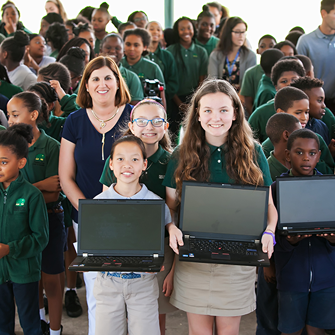
In the last decade, recycling technology has advanced significantly, substantially impacting our communities. More and more people are becoming aware of the benefits of recycling, not only for the environment but also for the local economy and global climate change. Many of us are actively seeking solutions to reduce our environmental footprint by recycling our household waste. Technological advancements have made recycling a more practical and realistic option, enabling communities to manage more recyclable materials than ever before.
Today, in 2024, industrial companies and small businesses are reaping numerous benefits associated with investing in recycling technologies. As a result, recycling has now transformed into a major industry and is contributing to the overall growth of the recycling sector. Furthermore, advancements in recycling technologies have allowed large-scale facilities to process more recyclable materials and have enabled smaller communities to establish their local recycling programs.
Major tech companies like Google, Apple, and Amazon are playing a central role in modern recycling. Collectively, these companies are expanding their presence in the recycling industry by investing in new factories and facilities where they process recyclable materials. They not only have the capacity to dramatically increase our recycling capabilities but are also actively developing new recycling technologies to help us better manage our waste.
For example, Apple’s new recycling plant in Austin, Texas, uses robotics to break down old iPhones and iPads into their components. This system reduces the amount of labor required in the recycling process and allows Apple to reuse parts and materials more efficiently and effectively. This not only lowers the recycling costs for these devices but also reduces the amount of raw materials needed for new devices.
All these advancements in recycling technology benefit not just large corporations but entire communities. Informed consumers are now seeking environmentally friendly companies that actively reduce their waste production. This means that businesses across all sectors are viewing recycling as a strategy to improve their image and lower costs associated with waste disposal.
Here are some ways in which recycling technology is impacting entire communities:
The opportunities associated with recycling technologies represent an exciting new frontier. For communities looking to be more environmentally conscious, recycling offers an extremely practical and affordable option. Recycling technologies will not only help reduce waste disposal costs but will also foster innovation, create jobs, and decrease our dependence on raw materials while helping to prevent resource scarcity. As we continue to seek a sustainable future, it is clear that recycling technology will play a central role in uniting communities around the common goal of environmental management.
Fill out the form below to request your electronics recycling pickup.
We’ll coordinate the schedule logistics and follow up with next steps.
Got a pile of old computers sitting in a corner? Perfect. That’s the first step — realizing they could still make a difference. The next one is easy: let us take care of everything for you.
Here’s how our electronics recycling pickup service for businesses in the U.S. works, from start to finish.
Just tell us what type of devices you have — computers, laptops, printers, routers, cables — how many, and where they’re located.
We’ll confirm the pickup date and time and handle the logistics, so you don’t have to lift a single monitor.
Before our team arrives, gather your electronics in one accessible place and, if possible, remove batteries. You can also wipe your drives, although we provide certified data destruction once everything reaches our facility. The U.S. Environmental Protection Agency (EPA) recommends clearing sensitive information before recycling or donating any device.
Our team shows up on the scheduled day, tags and loads the equipment carefully, and transports everything to our Tampa, Florida, facility.
Once there, we log and verify every item to ensure complete traceability — something your sustainability or compliance reports will definitely appreciate.
After intake, each device is inspected.
Some are refurbished and donated through our social programs. Others are processed for responsible recycling.
We follow strict environmental and data-handling standards, including R2 Certified and e-Stewards® certifications, both recommended by the EPA.
For devices containing storage — hard drives, servers, laptops — we perform secure wiping or physical shredding, depending on the type of hardware.
Our process complies with HIPAA and other federal standards for secure data disposal.
The EPA outlines similar steps: dismantling, shredding, and mechanical separation to ensure safe e-waste management.
When a device can’t be repaired, we disassemble it completely to separate metals, plastics, and other recoverable materials.
Those materials go back into production streams, helping reduce e-waste and energy consumption.
According to the EPA, recycling one million laptops saves the same amount of energy used by more than 3,500 U.S. homes in a year.
At eSmart Recycling, part of our revenue goes to refurbishing and donating working devices to children and families who need them most.
Once everything is processed, your company receives a data destruction certificate and a recycling report showing how many devices were recycled, refurbished, and donated.
You can include these documents in your sustainability reports or internal audits with full transparency.
Because we make it easy. We handle logistics, ensure compliance, and give your unused tech a second life. Most importantly, we do it safely, transparently, and responsibly — from pickup to final report.
Ready to schedule your pickup? Do it today through our form: https://esmartrecycling.com/individual-dropoffs
Your ESG plan—environmental, social, and governance—already drives how your company operates. But there’s one piece that often gets overlooked: what happens to your old tech. At eSmart Recycling, based in Tampa, Florida, we handle electronic recycling from start to finish: pickup, auditing, secure data destruction, valuation, and donation. Here’s why adding us to your 2026 ESG strategy can make a real difference.
When companies discard computers, printers, routers, and cables, those devices often end up stored indefinitely or in landfills with no traceability. But electronic waste is one of the fastest-growing waste streams on the planet. In 2019, the world generated 53.6 million metric tons of e-waste, yet only 17.4 % was properly recycled.
Proper recycling prevents toxic elements like lead, mercury, or cadmium from leaking into soil and water.
When you work with us:
The social benefit is simple but powerful: part of the equipment we collect is refurbished and donated to underserved communities. At eSmart Recycling, about 30 % of our revenue goes toward repairing and donating technology to kids, families, and schools that need it most.
On the governance side, our certified data destruction and transparent reporting give your company verifiable control over asset disposition. You get destruction certificates, audit trails, and measurable outcomes—exactly the kind of evidence investors and compliance teams expect in ESG reports.
By 2026, those metrics—“X devices recycled, Y kg of materials recovered, Z families helped”—can appear directly in your sustainability disclosures and annual reports.
Regulations, investor pressure, and consumer expectations are rising fast. Companies that already integrate responsible e-waste practices are ahead of the curve. According to IBISWorld, the U.S. electronic recycling industry is growing at a compound rate of 8 %, showing how essential this service has become.
Meanwhile, new ESG tools—like the carbon avoidance calculator by e-Stewards and Bloom ESG—help organizations track emissions prevented (Scope 4) through recycling and refurbishment. Partnering now ensures that by 2026, your company has verified, report-ready data instead of vague commitments.
If your organization wants a partner who collects, audits, wipes, and redeploys technology—while supporting real people in the process—we’re ready. At eSmart Recycling, we help companies make their ESG strategy tangible, verifiable, and good for everyone involved.
When we discuss electronic waste, most people envision large appliances. But the truth is that the biggest polluters are often sitting right on your desk. From laptops and servers to routers and printers, these devices are responsible for millions of tons of e-waste each year. Here’s a quick look at which devices cause the most harm and what your company can do to manage them safely — with a little help from us at eSmart Recycling.
Business IT equipment and office electronics are among the top sources of toxic waste worldwide. Common devices like computers, monitors, printers, routers, and smartphones are all considered e-waste once they’re no longer in use.
According to the United Nations Institute for Training and Research (UNITAR), the world generated 62 million metric tons of e-waste in 2022, but only 22.3 % was properly collected and recycled. Meanwhile, smaller IT devices such as laptops and phones contribute billions of pounds of additional waste every year due to their short life cycles.
When electronics aren’t handled correctly, the consequences go far beyond clutter:
By working with us, your company not only reduces environmental harm but also receives certified data destruction, detailed audit reports, and social and environmental tracking — all while supporting community reuse programs.
Here’s a practical roadmap that works for any organization:
The most polluting devices aren’t always the biggest ones. In most cases, they’re the everyday IT and office tools that quietly pile up over time. Managing them properly protects your company’s reputation, ensures compliance, and gives your equipment a second life.
If your business is in the U.S. and looking for a partner to recycle technology securely and responsibly — while making a real social difference — we’re ready to help at eSmart Recycling.
Every year, many laptops are no longer used by companies across Tampa. Some are stored “just in case,” others are replaced due to internal policy changes, and some simply leave the operational cycle. What we saw this year is that, when those laptops are handled responsibly and through the right partnerships, they can serve a very concrete purpose for students who truly need them.
That’s what happened throughout 2025 thanks to the joint work between eSmart Recycling, Digital Education Foundation, and the Sheriff’s Hispanic Advisory Council (SHAC). Laptops that no longer had a place in an office became everyday tools for students to study, stay connected with their schools, and continue learning with fewer worries.
In many organizations, device replacement is routine. Systems change, processes are updated, and laptops are retired before reaching the end of their usable life. The challenge appears when those devices sit unused or are discarded without proper handling.
At that point, more than reusable material is lost. There’s also a missed chance for those devices to remain useful for students who don’t have access to a personal computer at home. In daily school life, that absence is felt more often than it seems.
The U.S. Environmental Protection Agency explains that responsible electronics recycling enables the recovery of valuable materials while reducing environmental and data security risks when proper standards are followed.
In practical terms, this means a well-managed laptop can re-enter circulation and serve a clear purpose where it’s needed most.
Throughout 2025, we took part in three laptop deployments at public schools in Hillsborough County: Wimauma Elementary School, Davidsen Middle School, and Spoto High School.
In total, 214 laptops were delivered, directly benefiting 856 people, including students and their families.
These deployments were possible thanks to a collaborative model. The Sheriff’s Hispanic Advisory Council (SHAC) played a key role through community investment and coordination, while eSmart Recycling enabled access through its circular model, recovering laptops via responsible electronics recycling. Digital Education Foundation supported the social and community side of the effort, helping ensure each device reached the students who needed it most.
Rather than a one-time action, this work relied on close coordination with school staff, members of the Sheriff’s Hispanic Advisory Council, HCSO deputies, and our technical teams. That preparation showed in every deployment, in how smoothly the process ran, and in the calm shared by everyone involved.
The participating schools serve a high number of Hispanic students. In many households, having a personal computer remains difficult. This reality shows up in postponed assignments, limited access to school platforms, and added pressure on families and educators.
Data from the National Center for Education Statistics shows that access to devices continues to vary significantly based on socioeconomic factors, even in districts with strong infrastructure.
Addressing this gap requires coordination, funding, reliable technical processes, and partnerships that work well on the ground. During these deployments, we saw how collaboration between schools, SHAC, Digital Education Foundation, and eSmart Recycling helped laptops reach the students who needed them, without unnecessary friction.
At eSmart Recycling, we operate under the R2v3 standard, one of the most demanding certifications in the U.S. electronics recycling sector. This standard defines how data is handled, how equipment is processed, and how materials are managed throughout the entire lifecycle.
For companies, this provides peace of mind. Their data is handled securely, and their devices are processed through audited practices. For educational communities, it means the laptops delivered are suitable for academic use.
The laptops delivered meet very practical needs. They allow students to access learning platforms, take part in virtual classes, build digital skills, and communicate more easily with teachers and schools.
During the deployments, we saw how having a personal device eased everyday stress and allowed attention to return to what matters most: learning, keeping up, and staying connected.
No formal quotes were collected, but the atmosphere was consistent across all three events. Students showed excitement, teachers felt more at ease, and school teams were fully engaged.
That kind of energy appears when everyone understands their role and follows through on what was agreed. It shows in small details and in how people interact throughout the process.
For many companies, laptop recycling is simply another operational task. Our experience shows that, when done responsibly, it can also become a meaningful way to support the local community.
By recycling their technology with us, companies meet recognized standards, reduce data-related risks, and support local education initiatives in a verifiable way.
This isn’t just about removing old devices from inventory. It’s about allowing those devices to remain useful where they are needed most.
This year reinforced how much early coordination matters. Setting reminders at 90, 60, and 30 days for all parties involved helps keep information aligned, especially when school staff or academic calendars change.
The message for companies is simple: by recycling technology responsibly, they can help students access the tools they need and strengthen educational communities, without compromising security or compliance.
Reducing tech waste in IT projects is just as important as keeping your infrastructure running smoothly. If you manage sustainability or IT for a company in the U.S., this article breaks down three practical ways to minimize electronic waste (e-waste) — and how we, at eSmart Recycling, can help you do it safely, responsibly, and profitably.
Every year, millions of tons of electronic devices reach the end of their life. According to the Global E-waste Monitor 2024, 53.6 million tons of e-waste were generated in 2022, and only about 20% was properly collected and recycled.
For organizations managing large IT infrastructures — servers, workstations, peripherals, and networking gear — that means:
Start with a clear inventory of all your IT assets — their condition, age, and actual usage. This lets you decide when to repair instead of discard, reassign devices to less demanding roles, or plan gradual replacements instead of mass hardware turnovers.
Many companies now use leasing or “hardware-as-a-service” models that make upgrades more predictable without generating huge waves of waste. Extending device lifespan reduces e-waste and helps you stabilize your IT budget at the same time.
When equipment leaves your main operation, it doesn’t have to go straight to a landfill. That’s where we come in. At eSmart Recycling, we collect, audit, and securely destroy data following strict standards like HIPAA. Then we refurbish, value, and donate part of the recovered technology — roughly 30% of our revenue goes toward restoring devices for underserved communities.
This turns what could have been waste into social value. For your company, it means a measurable reduction of e-waste and a tangible expression of corporate responsibility. Reuse and donation also send a strong signal to employees, clients, and regulators: your IT asset management doesn’t end when devices are decommissioned — it continues through their second life.
When devices truly reach the end of their usable life, proper handling is essential — secure data destruction, certified recycling, and material recovery. The Global E-waste Monitor estimates that only around 20% of global e-waste is officially tracked and recycled. In the U.S., the Environmental Protection Agency (EPA) reminds that electronics contain hazardous materials and should never end up in untreated landfills.
Working with eSmart Recycling gives your company certificates of data destruction, environmental and social reports, and full traceability for every asset — helping you stay compliant, transparent, and credible in sustainability reporting.
By applying these three strategies, your organization not only reduces electronic waste but also builds a stronger reputation, meets sustainability goals, and frees up IT resources for what truly matters.
Turning corporate social responsibility (CSR) into measurable action means going beyond good intentions. It’s about doing, tracking, and communicating. Here’s how companies in the U.S. can take tangible steps—and how we at eSmart Recycling do it every day.
Start by translating your company’s values into specific, actionable goals. For example: “Reduce electronic waste by 10% this year” or “Donate 500 refurbished devices to underserved communities.” Then assign metrics to track progress—devices collected, percentage reused, tons of e-waste diverted, etc.
Why it matters: 90% of S&P 500 companies now publish ESG reports, and 76% of consumers would stop buying from a brand that doesn’t protect social or environmental well-being.
At eSmart Recycling, we allocate about 30% of our revenue to repair and donate computers—this is one of our measurable KPIs, not just a statement of intent.
Once goals and metrics are set, it’s time to act. This can include audits, collection drives, NGO partnerships, or employee engagement programs. The key is to document every step so you can later report credible data.
For instance, a tech company can collect outdated routers and laptops, securely destroy data (as HIPAA requires in some cases), and donate the working devices. That’s exactly what we do at eSmart Recycling: we collect, audit, value, and repurpose technology so it keeps serving people instead of ending up as waste.
Documenting this process allows you to report outcomes such as: “We collected X tons of equipment,” “Reused Y %,” or “Donated Z devices to N families.” With real numbers, CSR becomes a visible action.
About 73% of investors now consider CSR practices in their decisions. Showing execution and documentation builds trust among employees, customers, and investors alike.
Finally, transparency turns action into credibility. Share what you’ve done, report your data, and review your progress regularly. Reports, certificates, and environmental or social summaries build trust and strengthen partnerships.
At eSmart Recycling, we share “certificates of secure data destruction” and detailed “donation reports” with our partners. This evidence shows accountability.
Revisiting your metrics often also helps: if your quarterly numbers fall short, adjust the plan—collect more, improve logistics, or engage more employees. Continuous measurement keeps your CSR program alive and credible.
Reporting is no longer optional: social and environmental disclosures are becoming standard business practice. Companies that show how they act—not just what they believe—stand out from those still talking about responsibility in theory.
Each of these steps—setting measurable goals, executing and documenting, communicating and improving—turns CSR from words into measurable results. If your company is ready to take that leap, we at eSmart Recycling can help with technology collection, data auditing, valuation, and device donation programs that make your social commitment measurable.







Did you enjoy our latest blog articles just above?
Subscribe to receive new stories, insights, and impact updates straight to your inbox.
We’ll send you curated content about our partners, recycling strategies, success stories, and how your involvement is driving change through technology access and digital empowerment.
💡 No spam, just the smart stuff.